There’s no shortage of reasons for invalidating a warranty. Trump them all with proper PM and get your claim honored
Once trucks are out the door, things happen that truck makers can’t control. That’s their argument when they deny warranty claims, and it holds legal water. That means buyers need to practice proper operation and maintenance. With newer trucks, that takes extra attention.
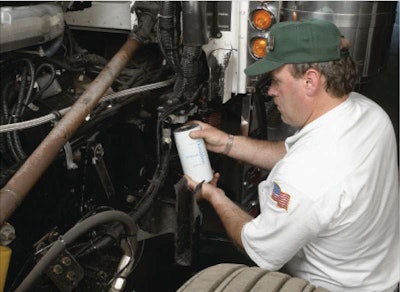 Changing fuel filters in a timely manner and using only those that meet factory specs is increasingly critical in preventing injector failure. When caused by dirty fuel, the failure would not be repaired under warranty.
Changing fuel filters in a timely manner and using only those that meet factory specs is increasingly critical in preventing injector failure. When caused by dirty fuel, the failure would not be repaired under warranty.“Many owner-operators just take their vehicle into a quick lube periodically for an oil change and figure they’re good to go,” says Michael Donnelley, service manager at MHL Kenworth in Little Rock, Ark. In reality, he adds, many warranty-related items you need to pay attention to aren’t covered in a quick oil change environment.
Basic preventive maintenance
“In the past five years, a lot of hoses, wiring, and piping, as well as new devices, have been added to meet the latest emission standards,” Donnelley says. “All these items need to be checked.” You need to keep wiring and hoses from contacting each other and the major components or you could easily experience a failure. This is an area of neglect that’s not warranted.
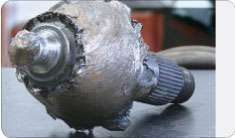 When a leak causes the lube level to drop below rear axle gears, they begin to run dry. Friction can make short work of the teeth on a pinion gear, not to mention all the bearings. Maintaining fluid level is the owner’s responsibility.
When a leak causes the lube level to drop below rear axle gears, they begin to run dry. Friction can make short work of the teeth on a pinion gear, not to mention all the bearings. Maintaining fluid level is the owner’s responsibility.Another classic failure is assuming that by keeping antifreeze/water proportions correct you have adequately maintained your antifreeze, Donnelley says. “But you may have let the diesel coolant additives, which need to be continuously replenished, get out of balance. You then discover exhaust pressure in the radiator, take the truck in, and are told the cylinder liners are pitted. If that results from improperly maintained coolant, it’s not warranted.”
Peterbilt’s Rick Wood, customer service director, urges a check of the antifreeze nitrite level. “Information about the proper level is found in the owner’s manual,” he says. He also notes the need to keep the coolant level at or above the “MIN” level line on the surge tank, to check hoses and clamps, including clamp tightness, and to periodically pressure-check the radiator cap. “Failure to regularly check these items can lead to failures of the cooling system and possible internal engine damage, which may not be warrantable.”
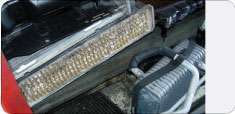 A lack of supplemental coolant additives can produce this kind of radiator clogging. Once clogged, operating pressure rises and the radiator is likely to leak, leaving you vulnerable to loss of coolant and overheating.
A lack of supplemental coolant additives can produce this kind of radiator clogging. Once clogged, operating pressure rises and the radiator is likely to leak, leaving you vulnerable to loss of coolant and overheating.Failure to perform prescribed PMs, such as routine inspection of hoses, belts, harnesses and other connecting components, can result in failures not covered under warranty, says Robert Correll Jr., service general manager for Daimler Trucks North America. Such problems could be avoided with practices as simple as replacing a tie-down, ensuring a hose remains routed away from nearby chassis parts, and avoiding use of fluids not approved by the manufacturer.
He warns against extending service intervals without lab tests and truck or component maker approval to justify the extension. And, always use engine oil that meets all requirements of the manufacturer; most have individual standards in addition to recommending CJ-4 for newer engines. Do the same with other fluids, such as antifreeze and trans and axle lubes.
Extending engine change intervals beyond factory recommendations is commonly feasible when the best oils are used and your application is easy on the oil. But it requires an oil analysis program and review of the data and approval by the engine manufacturer.
Correll also mentions a surprising glitch to a warranty – adding an inverter that is not properly designed, or failing to install the device properly. This can result in battery damage and starter issues, the latter since low voltage due to heavy discharge puts more amps through a starter even though you’ll get less cranking power.
Drivetrain issues
The use of proper fluids in drivetrain components “is important to maintain the product performance and maintain the component warranty,” says Rick Muth, manager of lubricants for Eaton and Roadranger. “For example, Eaton transmissions require lubricants that meet the PS 164 Rev7 specification and Dana components require a lube that meets SHAES 256 RevC.”
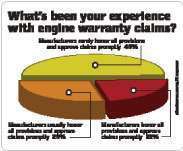
Muth points to seals – input and output seals, as well as wheel seals – as particular spots for pre-trip leak checks. “Any sign of wetness at all requires corrective action,” he says. “Failure to do so may result in component failure caused by low lubricant levels, and these types of failures are, in most cases, considered non-warrantable.”
Muth further recommends inspection of “the transmission and axle breather/air vent locations during a pre-trip to make certain that they are clear.” He adds, “Any blockage of the vent will cause the component to pressurize and create lube leakage.”
Both Wood and Allen list proper clutch adjustment as an important item to monitor. “Clutch adjustment is often determined by a certain amount of free travel measured at the clutch pedal in the cab,” Wood says. Even when a clutch is self-adjusting, it’s smart to check free travel to make sure the clutch is staying adjusted. Remember a clutch that’s not properly adjusted is a slippery slope – it causes increasing amounts of wear.
Proper operation
Keeping a warranty in force requires not only maintenance, but also proper operation.
“Always start in a low-enough gear to move the vehicle without using the throttle,” Muth says. “In other words, if you have to slip the clutch or the truck ‘lurches’ to get it moving, the clutch life will be shortened. And remember – clutch wear is always considered non-warrantable.” Starting in high range from a dead stop may damage transmission or driveline components, even when running bobtail. Evidence of improper gear choice would violate warranty terms.
There’s a reason truck drivers are sometimes referred to as “gearjammers.” It’s the job of the driver, not the shift collars, to synchronize mainshaft and gear speeds through proper double-clutching and timing.
“Smooth shifting means that the mechanical clutches are moving in and out of selected gears with no abnormal wear or snubbing,” Muth says. “This type of wear in a transmission is easy to detect in a repair and is, in most cases, considered to be non-warrantable.”
To be safe, Allen says, use the clutch. “Some drivers are not as proficient at shifting as they might think.”
During downhill braking, “over-revving of the engine may cause engine damage,” Correll says. This would include problems with valves or overheads. The governor function of the ECM will keep rpm from going too high under load but not when traveling downhill, even with the engine brake on. Watch the tachometer and control your speed with the engine or service brakes, or shift up if the rpm exceeds the governed speed or recommended maximum rpm, as listed in the owner’s manual.
Letting the engine idle for long periods can also cause severe damage, Correll says. “Excessive idle times can result in stuck valves, damaged clutches, etc.” Stuck valves come from oil sludge, while clutch damage can result from hours of sitting with the transmission gears clattering away.
As for the other kind of “idle” – a spare truck that’s sitting out a poor economy – Correll notes this as another warranty killer. “Failure to exercise inactive units can cause numerous system and component failures,” he says. n
Heed those warning lights
Dashboard warning lights have become especially critical since the introduction of diesel particulate filters because “a check engine light may mean your DPF needs to be cleaned,” says Michael Donnelley of MHC Kenworth. “That’s a critical part of maintenance. And just because you got a warning light the week before, don’t assume a current light is a result of the same problem.”
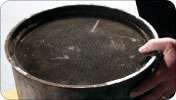 Failure to clean ash from the DPF on schedule can result in clogging, overheating, and cracking of the expensive ceramic filter portion of the device.
Failure to clean ash from the DPF on schedule can result in clogging, overheating, and cracking of the expensive ceramic filter portion of the device.The check engine light could indicate a DPF problem or a number of others. It means you should take the vehicle in and get electronic diagnosis.
Likewise, an ABS light in the cab should be addressed with diagnostics, says ArvinMeritor’s Charlie Allen. “Don’t ignore it,” he says.
Other warranty savers
There are other best practices that will prolong a truck’s lifespan and have a positive effect on getting a warranty claim approved. Failing to match transmission, driveshaft, and axle torque ratings will void a warranty, and this can happen as a result of upgrading an engine’s power and torque via reprogramming the ECM. Other errors like spec’ing a truck for the highway and then using it in on-off road service could also void a warranty, especially in the case of all but the newest automated transmissions.
SPEC FOR THE APPLICATION. “Vocations command specific vehicle and component specifications,” says ArvinMeritor’s Charlie Allen. “And note that the warranty may vary by vocation.”
Kenworth Public Relations Manager Jeff Parietti says to approach buying a truck with information about how you will use it, rather than specific component choices. When ordering new, he says, seek the dealer’s advice for your application. “Above all, don’t insist on a combination of specs the factory won’t approve,” he says. “Forcing them to build a truck that is not approved or better yet recommended will often lead to trouble and is likely to immediately raise warranty issues.”
If you’re buying used and getting an extended warranty, Allen notes, “check the level of components for the exact application you are applying them to. Be certain the clutch, driveline and transmission can handle any increase in torque levels. Avoid overloading the components to maximize life and performance.”
INSPECT SUSPENSION SYSTEMS. “Use a torque wrench to check for proper torque on U-bolts, frame bolts and suspension mounting hardware,” says Peterbilt’s Rick Wood. “Proper torque values are listed in the vehicle operator’s manual under the maintenance section for frame fasteners. Failure to check and maintain proper torque values can lead to component failure.” Obviously, a failure resulting from something that loosened up and was never retorqued is not covered by warranty.
International’s Brian Mulshine says it’s critical to perform the routine maintenance required on the DPF’s fuel dosing nozzle, especially on vehicles that spend time off the highway. Failure to do so may mean un-atomized fuel, ineffective active regeneration, and clogging. Also, where engines use in-cylinder dosing, change the oil religiously and watch for signs of fuel dilution. Changing in a timely manner is critical in these cases.
He also recommends doing overheads as recommended in the maintenance schedule, even on engines with common-rail injection, where that affects only the valves.
GREASE WITH CARE. When greasing U-joints, says MHC Kenworth’s Michael Donnelley, grease until you get fresh grease at all four bearings. “Don’t quit as soon as you hear the pop of the first fresh grease flowing past the seal,” he says.
Allen lists the need to grease slack adjusters until new grease purges from around the inboard camshaft splines and from the pawl assembly.
STUDY THE OWNER’S MANUAL. Donnelley says you can skim through the owner’s manual of a new car and it won’t matter that much. But on a late model truck, “Be proactive and try to educate yourself,” he says. “With older, mechanical engines, there was some leeway when something got out of adjustment. This is not true of the latest equipment.” He recommends studying the owner’s manual to become familiar with maintenance requirements and signs of trouble.
KEEP ALL SERVICE RECORDS. If your maintenance habits are challenged, you need to prove your diligence. Having as much service as possible done at the same location can make this easier since there would be a single source of backup documentation.









